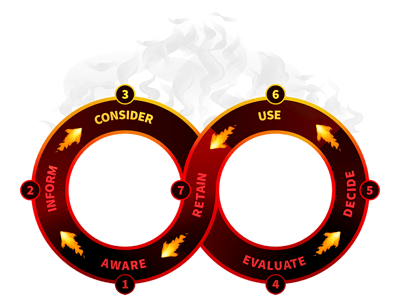The customer purchase cycle is rarely cyclical
October 5, 2015
By Rod Griffith
November 3, 2023

So, you’ve been assigned market development funds (MDF) from one of your alliance partners, and now you’re trying to determine how you should spend these co-marketing funds. You’ve probably got a lot of marketing initiatives on your plate, but you want to take advantage of these funds before they expire.
In my previous article, “6 important MDF do’s and don’ts to secure your marketing success,” one of the key recommendations was to avoid using the funds simply to offset the costs of already planned and budgeted marketing efforts. That internal budget is already approved. While it may delight your finance manager, offsetting current costs with MDF doesn’t further accelerate the customer buying journey.
That is exactly where smart marketers focus their MDF efforts.
Look closely at your customer buying journey and determine at which stage you most need marketing initiatives (such as sales tools, programs, or campaigns) to help address and overcome the roadblocks and challenges that prevent customers from moving to the next stage.
First, let’s look at the complete customer journey roadmap.

Notice that the journey does not end with the purchase of your product (stage 5, Decide). Most marketing initiatives are focused on the pre-sale segment of the journey (stages 1–5), with little attention (or budget) applied to post-sale initiatives (stages 6 and 7).
Here are some helpful insights and recommendations to help you decide where MDF can have the most positive impact.

At this earliest stage, marketing initiatives help the customer become aware of the problems and challenges that your product addresses. If your prospects are simply not aware of your solutions and how they address key challenges/needs, consider using your MDF to create sales tools and campaigns that help the customer evaluate their situation, identify the need, and understand that your solution can help overcome a major challenge and/or accelerate a key business goal.
MDF initiatives at this stage are typically high-level, educationally focused sales tools combined with inbound and outbound awareness-focused initiatives. Blog articles, newsletters, white papers, and statistical infographics can be very effective in generating awareness of the problems and challenges that your product solves.

At this stage, customers are generally aware of their challenges and recognize that third-party solutions like yours can potentially help address them. They actively seek advice and guidance relevant to their specifics, but they may not be ready to explore specific product details yet.
If your prospects are slow to move through this stage, focus your MDF initiatives on educational and tutorial sales tools and communications. Keep the efforts educational to help customers understand how they can address their challenges. Successful initiatives at this stage subtly establish your credibility, experience, and expertise without obvious sales pitching. Explainer videos, interactive presentations, and brief customer testimonials are often useful.

At the Consider stage, prospective customers are aware of their challenges and are actively exploring third-party solutions to define the set of potential vendors and products that best fit their needs. They are also looking to establish the relevant budget.
Your primary goal at this stage is to rank highly on the customer’s shortlist. If you’re having challenges with this, consider using your MDF to implement sales tools and marketing campaigns that position your product as the ideal solution for the business challenges and goals at hand.
There are a wide range of sales tool types designed for this stage, including brochures, white papers, success stories, and tutorial videos. Also consider tools designed to better train and arm your sales force (or channel sales force) to help customers through this critical journey stage, such as battle cards, sales playbooks, or sales training events/programs.

In this stage, prospective customers clearly understand the issues and recognize the need to pursue a solution. They have identified a shortlist of credible vendors. And they now need to select the ideal vendor and product to move forward.
If getting your prospects to decide that you provide the best solution is a challenge, consider using MDF to help the customer conclude that your offering is superior to other options. Effective programs and tools for this journey stage include data sheets, competitive comparison charts, online ROI and TCO calculators, industry analyst papers, and campaigns promoting trial or test offers.

If your customers get through most of the sales process, but hesitate to make the final buying decision, consider using your MDF to help push the customer over the decision fence. Tools and programs such as competitive trade-in programs, special discount offers, and bundled incentive offers may assist in that final push to closure.
Other MDF initiatives designed to accelerate customers through the Decide stage include tools that help salespeople build solid, well-designed proposals that offer a consistent, thorough case for your product.
These last two stages of the customer journey (Use and Retain) are most often underfunded, weakly focused, and underpowered. With thoughtful examination, you may find you will get the most incremental benefit from post-sale initiatives designed to encourage current customers to use your products more successfully, use more of their functionality, and/or upgrade to new versions.

Are your customers getting the maximum benefits from your product? Or are they underutilizing your product by using its core functionality only? (One client of ours found that customers on average used only 28% of their product’s full features.)
Consider using your MDF to develop sales tools and promotions designed to help the customer receive (and recognize) the maximum benefits from your product. These may include product use guides, tutorials that explain all of your product’s features (or showcase potential new ways to use it), webinars that show how to get the most from your product, and case studies of customers who’ve fully implemented it with great success.

Finally, consider using MDF to build customer loyalty by creating programs and tools that promote product upgrades, add-on products, or other offerings. You might also set up a customer/user group (or special interest group) for you and your alliance partner(s).
Tools and initiatives at this stage often invite and encourage participation in customer loyalty programs, satisfaction surveys, customer forums, conferences, or workshops—or request testimonials or referrals. Sample efforts include event programs and invitations, ongoing customer newsletters, add-on product promotions, and product or technology roadmap presentations.
The first step in determining where to use your MDF assistance is pinpointing where in the customer journey your sales team (or your channel partner’s sales team) faces the biggest challenges. By finding out where your sales are being slowed or thwarted, you can focus on creating initiatives and tools that align with those stages in the total customer journey.
As with any MDF initiative, always check with your MDF partner (your funding source) to ensure that your plans are fully approved and qualified for reimbursement.
Good luck!
Few, if any, marketing services companies come close to MarketReach’s deep experience in implementing effective, successful MDF marketing initiatives. We have been helping B2B technology companies get the most out of their MDF for almost 30 years. Contact us today for a free consultation.
We take pride in a team loaded with smarts, wit, and ideas. If you'd like to have a smarter, wittier inbox filled with ideas each month, subscribe here to the MarketReach Blog, and we will let you know when there is something new you might like!

Need us now? Just want to learn more? We’d love to talk.